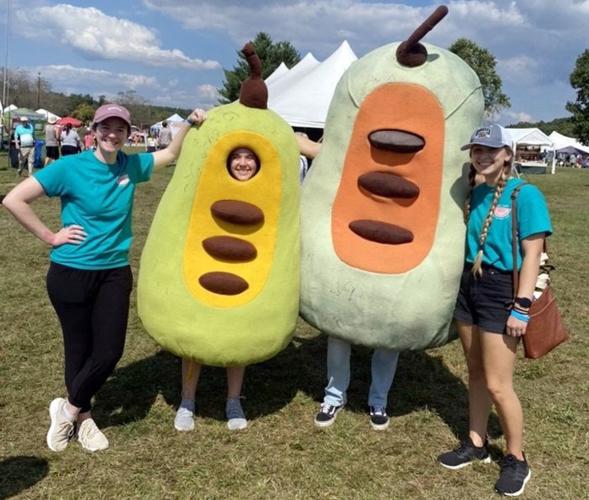
When life gives you pawpaws, throw a giant festival

Often overshadowed by more mainstream fruits like apples, strawberries, and oranges, the pawpaw, an unusual and exotic fruit native to the area, takes center stage one weekend each September at the annual Pawpaw Festival. Celebrating the unique flavors and rich cultural heritage of the pawpaw, this festival has become a beloved tradition in the region.
The pawpaw, sourced from the largest edible fruit trees in North America, boasts greenish-blackish skin and pale to bright yellow flesh with dark brown seeds. Its distinct flavor, often compared to a blend of mango, banana, and citrus, gives it a tropical twist that stands out.
The Native Food Education Organization, a non-profit lead by OHIO alum and Integration Acres (the largest pawpaw processor in the country) co-owner Chris Chmiel, spearheads the Pawpaw Festival, which occurs every September during the peak ripeness of the fruit. Visitors can not only taste the pawpaw but also savor dishes and products made from this peculiar fruit while immersing themselves in the local businesses that make up the region.
Robert Brannan, a professor of food and nutrition sciences at OHIO's College of Health Sciences and Professions (CHSP) and a member of the Native Food Education Organization Board, has dedicated a significant portion of his career to studying the pawpaw. His mission is to educate festival-goers about the fruit's benefits and unique attributes.
"There is very little research done on the pawpaw, so my goal is to study the benefits people can get from this fruit and hopefully find a way to make it more accessible for people all over, rather than just in the region it's indigenous to," Brannan said.
One of the challenges in commercializing the pawpaw lies in its limited shelf life. The fruit grows from late July to early October and begins to ripen as soon as it's picked, making it challenging to transport over long distances. This aspect hinders its economic potential compared to other more stable foods.
"Pawpaws suffer similarly to bananas in terms of ripeness," Brannan explained. "They often brown and develop textural issues even faster than bananas do, limiting the time they are best to eat, especially as is. Because of this, pawpaws are more often made in ways to last longer, primarily being used in pawpaw beer production.”
Brannan's research encompasses various aspects, including nutrient content analysis, sensory evaluations, and antioxidant characterization, shedding light on the fruit's unique qualities and challenges.
To help educate the public on this fruit’s characteristics, Brannan leads a team of 10-15 nutrition students from OHIO who manage the education tent or Pawpaw Tent, providing information about the pawpaw's origins, uses, health benefits, and conducting food demonstrations. Their volunteer work has earned the College of Health Sciences and Professions sponsorship recognition from the festival organizers, while providing an experiential learning opportunity for students to work directly in food and nutrition.
Students play a crucial role in the education tent, leading food demonstrations and distributing samples to eager festival-goers. There is even a pawpaw cook-off that highlights how the exotic taste of pawpaws can be used in desserts, beverages, condiments and more.
"I really enjoy getting to connect with so many people who have such a deep love for pawpaws," Hannah Moore, a fourth-year Translational Health-Applied Nutrition major and President of the Nutrition Club who volunteered at least year’s festival, said. "I have family from Appalachia but had never heard of pawpaws until attending OHIO, so getting to unlock such a large part of the culture was so interesting... I also got to try a lot of pawpaw in different forms, which was so fun and delicious."
For many students like Moore, the Pawpaw Festival provides not only a unique cultural experience but also a glimpse into unconventional career paths in healthcare and nutrition.
"Volunteering and working with local organizations has shown me that there are so many more opportunities and career paths than the traditional clinical ones that many healthcare professionals think of," Moore concluded.
The Pawpaw Festival, which initially attracted around 500 attendees, has blossomed into a massive event, drawing approximately 10,000 visitors from across the nation. This growth not only celebrates the unique fruit but also bolsters the economic prosperity of the region.
"As a pawpaw aficionado, I always get excited about sharing this fruit with others,” Brannan added. “However, what really excites me about the festival is how well it showcases the amazing local businesses and vendors from this region to visitors from all over."
The Pawpaw Festival stands as a testament to the power of celebrating the local and the unusual, showcasing the rich diversity of flavors and cultures that make our world so fascinating.
